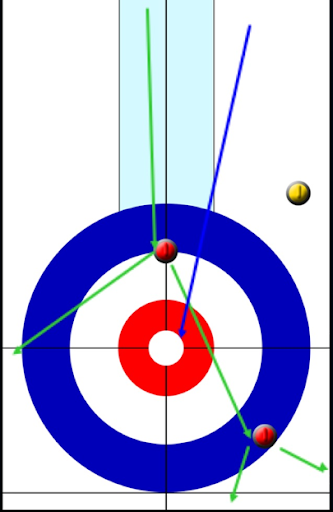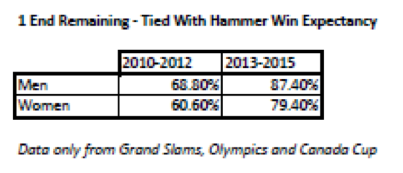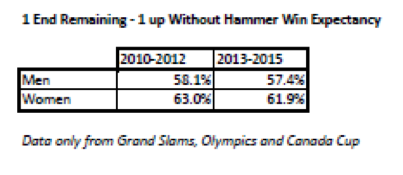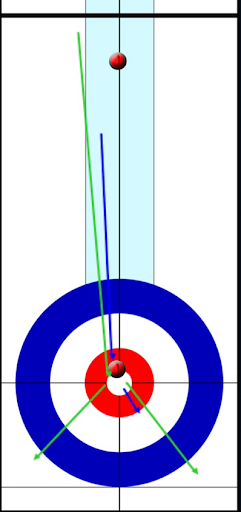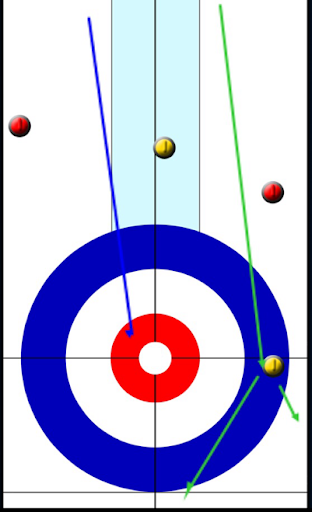Much of my strategy analysis is based in data, but I also believe what my childhood stats hero Bill James would protest,
"there are so many things that none of us know, no matter how detailed the statistics".
A skip is always making a strategy decision based on many factors, most of which cannot be analyzed with statistics. Even stats which are available need to be adjusted based on the conditions, the opponent, their team, and their own skills.
Warning to those right brain thinkers, we're going to dig a little further into the numbers than in our first pass.
Note: if you haven't read the original article, please go there first. Otherwise this will make even less sense. I wrote both and am still not sure what I'm talking about.
Situation 1: Steve Laycock
Steve has a choice between draw to the full four foot for 1 point or a hit and roll for 1 point. Let's estimate his odds at the draw are 95%. Let's estimate a steal of 1 is 3% and a steal of 2 is 2%. We'll use the WE chart for 4 rock FGZ (it's all we have for now) but increase the chance of a team 2 down with hammer to win by 3%. This is slightly better than just a wild ass guess. We do have a small sample of data from the 5 rock events which indicate that teams score threes about 3% more often. We need a couple of years more data to be more accurate but it seems like a reasonable start. We won't expect 1 down with hammer to change under 5 rock FGZ because thus far ends appear to play out identical as with 4 rock FGZ.
Win Expectancy (draw) = (.95)(.86)+(.03)(.79)+(.02)(.41) = .8489 or 85%
Estimate the hit and roll by Steve is made for 1 point 1/4 the time.
Win Expectancy (hit) = (.75)(.79)+(.25)(.86) = .8075
So these numbers indicate it's a 5% mistake.
What if Steve knows his lead makes the tick shot 80% of the time and when they make both ticks they win 100%. When they don't make both ticks they still win 70%. This would channge his WE when tied with hammer from .79 to:
WE = (.8)(.8)+(.7)(1-.64) = .892 or 89%
That's higher than our estimate for 2 up!
Replace .79 above in our equations with .89.
WE(draw) = 85.2%
WE(hit) = 88.3%
What looked originally to be a 5% mistake becomes a 3% advantage, if Steve's assessment of the ability for his team to execute the tick shot and finish the game tied with hammer is correct. And what if Steve doesn't expect to make the draw as high as 95%? Yes, a lot of IFs, but as we get more recent data on elite teams, we may see numbers which look closer to these results. Recall the previous chart (with a small sample size) shows recent Grand Slams (from 2012-13 Season to today) WE of 87% for tied with hammer in the final end.
Situation 2: Rachel Homan
Rachel can make the double for a blank (WE=.872) or will miss and give up a steal (.7).
Even more so than with mens data (for an up and coming team like Laycock), I'm willing to give Team Homan credit for having numbers which well exceed these averages for womens play. It's fair to say Rachel wins much more than 70% of the time when tied in the final end, and higher still when 1 up with hammer. In fact, Homan is 39-5 (88.6%) tied in the last or extra end and 11-1 (91.7%) 1 up with hammer in the final end. They are 19-1 (95%) when 2 up without hammer in the last end.
We could spend time trying to pull in data from other top teams and then use regression analysis to create a more confident estimate, But I don't have that much time on my hands.
Homan lead Lisa Weagle is so good at the tick shot they've started naming it a "weagle". Using the same formula as above for Laycock: assume she makes the tick shot 85% of the time (Rachel may even have these exact stats). Assume they also win 100% of the time both tick shots are made. When one or both ticks are missed, let's guess that Homan wins 60% of the time.
WE = (.85)(.85)+(.6)(1-.7225) = .889 or 89%
You may notice this is very close to their actual results.
The arguement now boils down to Homan's expected WE for the other conditions (1 up with and 2 up without hammer). 89% is higher than the womens averages for both these situations and if we use them the hit becomes an obvious decision. It seems obvious that as one of the top 3 teams in the world, Homan is well above the average, but how much?
It's late and I feel like I'm repeating myself. I think we get the idea.
One thing we find in both these decisions is it is closer than initially thought and when a team is in this dominant position, the wrong decision won't be that big of a mistake. Trying to decide whether you chose to have an 88% chance to win or an 90% is not a large error, especially given these numbers are not absolute for a particular team and situation.
I've talked before about the problem with "average" in our data and the elite teams. When I've run samples of different levels of teams (at least for mens), what stands out is that most numbers look fairly consistent, except for tied with hammer, where the team with hammer has a 4-5% advantge. The reason is the position of tied with hammer is less influenced by the skill of the opposing team and a large impact based on the ability of the team with hammer to clear free guards and draw for a point. Given the improvement by elite leads to make the tick shot most of the time, this gap is only getting larger.



